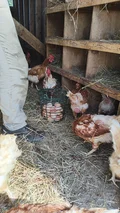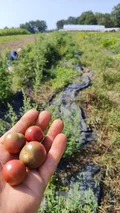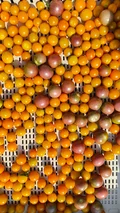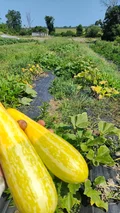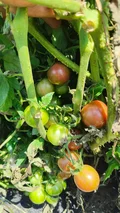TL;DR
A farmer generally doesn’t get a day off until time is made for that sort of thing. There’s enough of us to cover a few days for Jamie this week, so during a third heat wave this year, we harvested tomatoes, eggplant, sunflowers, peppers, and celery as well as did chores.
How Do Farmers Get a Day Off?
Consider a few things about the life of a farmer:
1) Weekends aren’t something nature recognizes; they are a human invention that can be ignored. 2) If you don’t have someone that can handle all the tasks you can, a day off is risky 3) Even if you have someone that can handle all the tasks you can, a day off is risky 4) You can easily burn out if you don’t take a day off here and there
Generally, every day has the same start and finish chores, but during the season mak also include trips to the market. So the heavy work is done in the mornings with possibility for some afternoon projects until pack-up time comes. “Sleeping in” is a luxury, maybe a Saturday morning here and there, but only until about 7am. Generally, it’s a 12-16 hour day for the primary and/or owner of a farm.
A low/no worry day off is a work of personal art. No one else is going to do this for you, and it takes more than just you to make it happen. A few things are important to getting a day off from the farm worth the effort to get one:
- having a well-trained right hand person that can management while you’re away
- doing everything you can to make the day(s) off as risk-free as possible
- scheduling the time off in advance, timed to non-market days and coordinated with others’
It’s Hot on the Landscaping Fabric
There are a few fields where we use landscaping fabric to minimize weeds around long-growth plants like eggplants, tomatoes, summer squash, kale and chard. It makes sense and is a good investment, but it’s also terribly hot on the fabric during a heat wave. It’s so hot that tomatoes low on the plants accepting heat from the fabric are hot (not warm, but hot) to the touch.
That the tomato plants are thriving means that their roots are deep and strong, able to withstand the heat and still produce fruit. Granted, we had a little rain last weekend but not enough to make a difference in this field. The irrigation system of hoses around the field and a movable industrial tripod sprinkler are helping to keep the plants hydrated.
Blog Improvement Delays, but Dehydrator Yay’s!
I wish there was more to say today about process changes I intended to make on this blog, but this weekend was a bust for my tech work. Not a lot got done on it, but projects around my house did.
One thing that did finally happen was that I received a Cosori food dehydrator just in time for tomato season. Fully dehydrated tomatoes are a great way to preserve and intensify the flavor of fruits and veg, especially tomatoes. I already ran a first batch of 5 lbs of tomatoes through it, resulting in only a small sandwich bag’s worth of ‘tomato chips’. Every non-customer tomato I can take home from the farm will have a place in my pantry this winter.
AI Generated Summary from Notes
Final Consolidated Summary
Main Themes
- Environmental and Operational Challenges: Farming in extreme heat, mosquito-prone conditions, and limited infrastructure (e.g., solar battery issues, barn fan inefficiency).
- Crop and Animal Management: Harvesting, seed tray preparation, egg monitoring, and adapting to avian flu disruptions.
- Labor and Infrastructure: Labor-intensive tasks (cleaning, harvesting) and recurring infrastructure problems (pig fence battery failures, seed tray setup).
- Adaptation and Planning: Adjusting to supply chain disruptions, weather conditions, and long-term farming strategies (e.g., seed tray schedules, egg quality tracking).
Key Activities
- Crop and Animal Tasks: Harvesting crops, cleaning barn floors, washing vegetables, and monitoring egg production.
- Infrastructure Maintenance: Replacing pig fence batteries, troubleshooting solar charging issues, and preparing seed trays.
- Egg and Seed Management: Tracking egg size and quality, preparing seed trays for lettuce, and diversifying chicken sources.
New Challenges and Observations
- Environmental Pressures: Extreme heat, mosquitoes, and limited shading for crops.
- Infrastructure Limitations: Persistent pig fence battery failures due to solar charging constraints.
- Supply Chain and Health Risks: Avian flu impacting chicken availability and egg supply.
- Seed Tray Use: Preparing seed trays in shaded, well-ventilated areas for lettuce planting.
Key Questions
- How to resolve pig fence battery charging issues (e.g., relocate panels, backup power solutions)?
- What alternative chicken sources or breeds can reduce reliance on national supply chains?
- What factors influence egg size and quality (e.g., diet, housing conditions)?
- How to optimize planting schedules for crops in extreme heat and limited shade?
- How to improve trellis management for vine crops in mosquito-prone areas?
Recommended Actions
- Infrastructure Solutions: Investigate alternative battery charging methods or backup power for pig fence systems.
- Diversify Supplies: Explore local chicken sources or breeds to mitigate avian flu risks.
- Track Egg Quality: Monitor egg size and quality to identify improvement opportunities.
- Plan Seed Trays: Schedule seed tray preparation and planting in shaded, well-ventilated areas.
- Train Workers: Develop efficient techniques for harvesting overgrown crops and managing infrastructure.
- Document Weather: Track weather impacts on farming activities for future planning.
This summary integrates insights from both documents, emphasizing environmental challenges, infrastructure needs, and adaptive strategies for sustainable farming.
Part 1
Main Themes:
- Weather and Environmental Challenges: Extreme heat, humidity, and a poor air quality index, along with a severe mosquito problem, made the workday difficult.
- Crop Management and Harvesting: Multiple tasks involving harvesting different crops (cherry tomatoes, eggplants, sunflowers, squash, and overgrown tomatoes).
- Labor and Physical Strain: The intern emphasizes the physical effort required, especially for harvesting tomatoes with overgrown trellises.
- Adaptation and Resilience: The intern reflects on how to work efficiently despite harsh conditions.
Activities the Intern Did:
- Assisted with chicken chores: Watering, collecting eggs, and providing fresh bedding.
- Harvested cherry tomatoes (yellow/orange, super tasty) from beds near shishito peppers, kale, and chard.
- Harvested eggplants and brought them up.
- Helped strip sunflowers of leaves, place them in water, and delivered them.
- Harvested summer squash and zucchini from a bed past the shishito peppers.
- Harvested overgrown tomatoes from a trellis system, requiring bending down and careful manual work.
New Things Not Yet Encountered:
- Cherry Tomatoes: Specific varieties (yellow/orange, “super powerful” and tasty).
- Trellis System Overgrowth: The challenge of harvesting tomatoes that have grown beyond their trellis, requiring manual, low-level work.
- Mosquito Problem: The intern describes a severe mosquito infestation that made the day uncomfortable.
- Air Quality Index: The poor air quality index on the day, which is not a typical focus for farm interns.
Questions and Future Areas of Research:
- How to Manage Overgrown Trellis Systems: What techniques can be used to prevent or correct overgrowth in tomato trellises?
- Mosquito Control: What methods are effective for reducing mosquito populations in the field?
- Impact of Heat on Crops: How does extreme heat affect the growth and yield of crops like tomatoes and eggplants?
- Air Quality and Farm Work: How does poor air quality (e.g., high temperatures, humidity) influence labor efficiency and safety?
- Harvesting Techniques for Overgrown Tomatoes: What tools or methods can make harvesting overgrown tomatoes less physically demanding?
Suggested Actions:
- Use Mosquito Nets or Repellents: To mitigate the severe mosquito problem and protect workers.
- Adjust Trellis Systems: To prevent overgrowth and make harvesting easier.
- Monitor Weather Conditions: To plan work schedules around extreme heat and humidity.
- Improve Air Quality: Investigate methods to reduce the air quality index (e.g., shading, water misting).
- Train Workers on Efficient Harvesting Techniques: For overgrown tomatoes, to minimize physical strain and maximize productivity.
Part 2
Main Themes
- Farm Work and Labor: Heavy harvesting, cleaning tasks, and maintenance activities.
- Equipment and Infrastructure: Maintenance of the pig fence battery, solar system limitations, and barn fan efficiency.
- Egg Production Challenges: Impact of avian flu on chicken supply, egg size, and production timing.
- Adaptation to External Factors: Adjusting to supply chain disruptions (e.g., avian flu) and weather conditions.
- Preparation for Future Tasks: Seed tray preparation for planting lettuce and planning for future planting cycles.
Activities Performed by the Intern
- Harvesting: Heavy harvesting in the field on a hot, mosquito-filled day.
- Cleaning: Swept and washed the barn floor.
- Potato Processing: Bagged approximately 70 pounds of potatoes.
- Vegetable Washing: Washed vegetables (excluding summer squash).
- Battery Maintenance: Swapped out the dead pig fence battery (recurring issue due to tree cover blocking solar charging).
- Seed Tray Preparation: Loaded 98 seed trays with potting mix for lettuce planting.
- Egg Management: Monitored egg production from new chickens, noting reduced egg size and increased supply.
New Things Not Yet Encountered
- Pig Fence Battery Issues: The recurring problem of the pig fence battery dying due to insufficient solar charging.
- Avian Flu Impact: The national supply disruption caused by avian flu, affecting chicken availability and egg production.
- Seed Tray Preparation for Lettuce: The process of preparing seed trays for planting in shaded areas outside the barn.
Questions and Future Research Areas
- Battery Charging Solutions: How to optimize solar charging for the pig fence battery (e.g., adjusting location, adding supplementary power).
- Egg Production Buffering: How to mitigate supply chain risks (e.g., diversifying chicken sources, increasing buffer stock).
- Egg Size and Quality: Why egg size is smaller now and how to improve production quality.
- Weather-Related Planting: How to adapt planting schedules (e.g., lettuce) to extreme heat and shade requirements.
Suggested Actions
- Investigate Battery Charging Solutions: Assess alternative methods to ensure the pig fence battery charges fully (e.g., relocating it to a sunlit area or using a backup power source).
- Diversify Chicken Sources: Explore alternative suppliers or breeds to reduce dependency on national chicken supply chains.
- Monitor Egg Production: Track egg size and quality over time to determine if adjustments (e.g., diet, housing) are needed.
- Plan for Seed Tray Use: Develop a schedule for seed tray preparation and planting in shaded, well-ventilated areas.
- Document Weather Impact: Record how extreme weather affects planting and harvesting to improve future planning.
[end of post]
Enjoy Reading This Article?
Here are some more articles you might like to read next:
